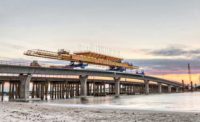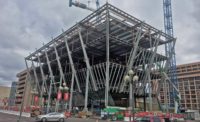Transportation was once again a driving force for designers working in California in 2018. In fact, four of the top 10 entries on the Top Design Firms list reported that transportation was their No. 1 revenue generator, while five of the top 10 said it was their No. 2 or No. 3 biggest sector.
One of the largest transportation projects to break ground in 2018 was the $4.9-billion Los Angeles World Airport Automated People Mover. HDR, No. 2 on this year’s ranking, is the lead designer for the design-build project, teamed with HNTB as design sub consultant.
HDR is also working on the $408-million OC Streetcar Project in the city of Santa Ana, once again working with HNTB, the No. 8 ranked design firm. For this project, HNTB designed the streetcar plans, with Walsh Construction in charge of construction. Scheduled to begin testing and operations in late 2021, the OC Streetcar will run on a 4.1-mile route, serving Santa Ana’s downtown areas.
Another hot market is education, where Santa Rosa, Calif-based Quattrocchi Kwok Architects (QKA) thrives.
|
Related Link |
“The biggest market drivers are the large number of local public-school bonds and the state’s $9-billion school construction bond, Proposition 51,” says Mark Quattrocchi, principal and founder of QKA. “Additionally, there is a high demand for major school renovations due to not only aging facilities, but pent-up demand resulting from the recession halting most school work.”
Quattrocchi, whose firm ranked 42nd on the survey and specializes in K-12 and higher education design, says the large volume of statewide construction and related shortage of contractors and subcontractors are creating extraordinarily high construction costs, particularly in the San Francisco Bay Area.
A couple of QKA’s largest current projects are a $47-million complete restoration and modernization of Alameda High School, a historic, 100,000-sq-ft, 1924 neoclassical school, and the design of the new $40-million, two-story Lila Bringhurst Elementary School in Fremont.
For 36th-ranked Steinberg Hart, the design climate is an across-the-board boon.
“Our existing markets are experiencing record growth, and we’re continuing to expand our geographical and market sector reach,” says David Hart, Steinberg Hart’s president and CEO. “We are also seeing robust repeat business from current clients and are working with leading national developers.”
Simon Ha, a partner with Steinberg Hart, says the firm’s hottest sectors, transit-oriented mixed use and hospitality, are being driven by a strong economy combined with a lack of housing supply that has driven up demand to a point of a housing crisis.
“As California policy continues to move toward carbon neutral, development policies are encouraging urban revitalization, mass transit infrastructure and building density in transit rich areas,” says Ha. “As urban renaissances in Los Angeles, San Diego, the Bay Area and Silicon Valley continue to advance, people are embracing the urban culture and increasing the demand for more jobs and housing in these cities.”
A prime example is Miro, a 28-story high-rise mixed-use project under construction in downtown San Jose, on which Steinberg Hart is the design and executive architect. The development, slated for completion in 2020, will be San Jose’s tallest and will have 630 units.
Stantec, the No. 3 firm on the survey, is also seeing positive results across its design practice. Alfonso Rodriguez, Stantec vice president and regional leader for the Pacific region, says business in California is noticeably improved over years past, while sectors that have been static are on the rebound.
Among the firm’s current health care projects is the $275-million University of California San Francisco Precision Cancer Medicine Building in San Francisco’s Mission Bay. Stantec is providing design, programming and serving as the integrated delivery partner for the project, which is nearing substantial completion and expected to house its first patients this summer.
The economy is also creating available funding for public office space design, says John C. Webre, CEO of Dreyfuss + Blackford Architecture. He adds that civic and mission-critical projects are among the firm’s hottest sectors.
Dreyfuss + Blackford’s biggest current job is Swing Space, a 476,000-sq-ft, $420-million design-build office building for the state of California in Sacramento. The company is associate architect with HOK, while Hensel Phelps is the builder. The 11-story project is headed for an August 2021 completion.








